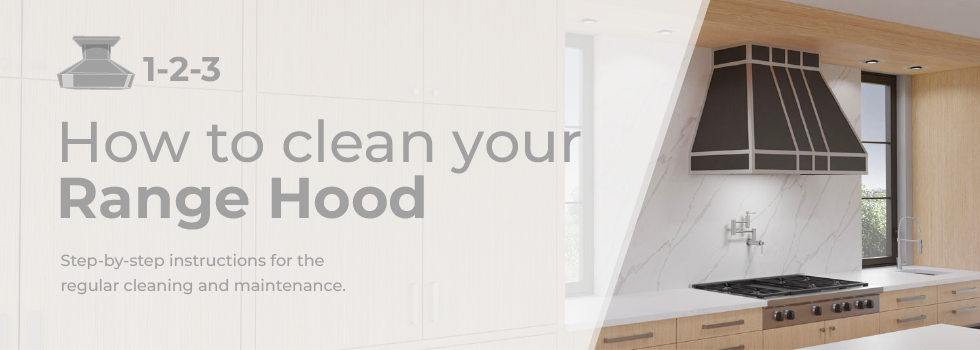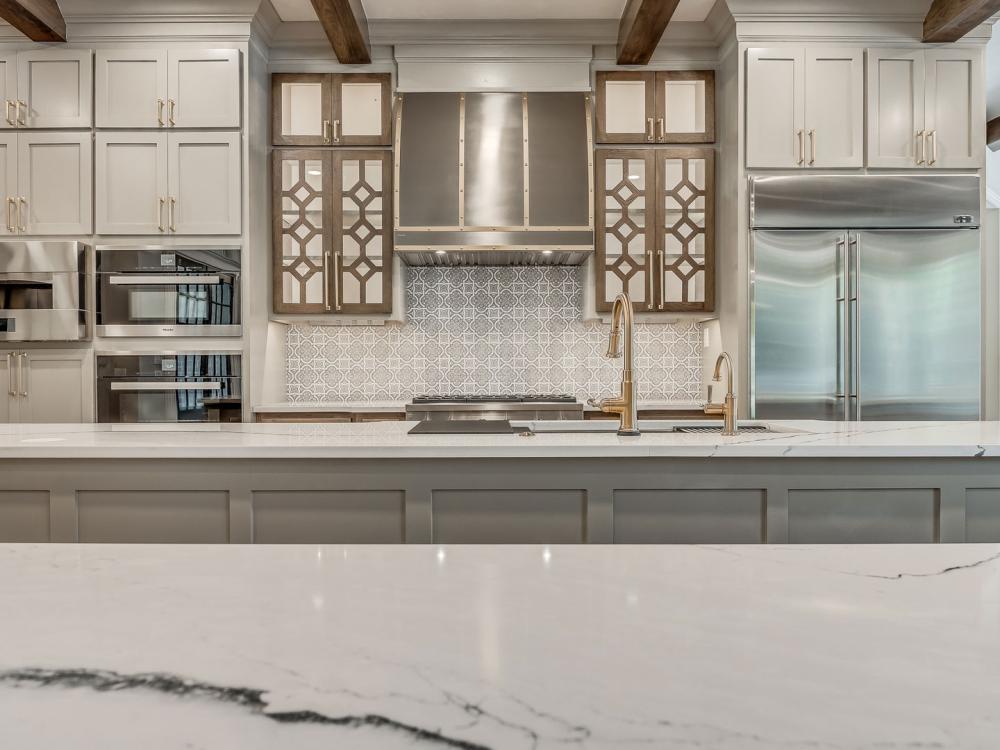
Right in the heart of your home, your kitchen, lies an unsung hero who does a great job of getting rid of the smoke and odors that come from cooking: your range hood. But even the best range hoods, like those CopperSmith handcrafts, need attention. The range hood filter plays an important role in the protection of your ventilation system. It removes grease and food particles to keep your air fresh and clean.
If you ignore the range hood, the performance and visual look will reduce. A large grease build-up increases the risk of a fire out-break. Since you made an important investment in quality with your range hood; now you need to actively protect that investment.
Let's get started with this complete step-by-step guide on mastering how to clean range hood filters effectively.
Why You Need to Clean Your Range Hood Filter Regularly
Importance of Maintaining a Clean Range Hood Filter
A clean hood filter will make sure that your range ventilation system works effectively and efficiently. Your range hood filter won't be able to remove airborne contaminants when grease fills it up. This increases the amount of work your range hood does. More so, its lifespan is reduced in the process. To prevent this, always perform regular maintenance.
Preventing Grease Buildup and Ensuring Kitchen Safety
When you cook, the oil from your food turns to vapor, and it sticks to the range hood. It gradually becomes a thick and flammable layer. When this grease buildup becomes severe, you must perform a deep clean. Failure to do this increases the risk of your range hood catching fire. You can prevent this scenario by cleaning your range hood filters monthly.
A Step by Step Guide: How to Clean Range Hood Filters Effectively

Step 1: Turn Off the Power and Remove the Range Hood Filter
The first thing to do is to consider your safety. Go to your circuit breaker and turn the power off. Do not rely on the fan switch only. You must completely disconnect the electricity so that no electric current can reach the interior of the hood.
The next thing to do is to remove the filter. Most modern range hood filters use a simple latch or spring clip. Gently open the latch to release it from the housing. Hold the filter firmly as you remove it, so you don't drop it into your sink or onto your range.
Step 2: Inspect and Prepare for Cleaning
Take a moment to check the state of the filter that you removed, and ask yourself this question: Is the grease buildup light and sticky, or is it heavy and baked solid? Your inspection will tell you the best cleaning method to choose next. Before you move the filters, lay down some old newspaper or a paper towel on your sink counter to remove any excess grease or remaining residue.
Step 3: Choose the Right Cleaning Method for Your Range Hood Filter
Dishwasher Method
If your range hood filter is dishwasher safe (many built in filters are), use this as the simplest option for light cleaning. First, remove any food particles. Then, place the filter inside the dishwasher, but make sure you don’t include other dishes if it’s heavily coated. Finally, run the machine on the hottest cycle, using your normal dish soap or degreaser.
Hot Water and Degreaser Bath Method
For deeper cleaning, you must soak the filter in water. Look for a large pot or a sink big enough to fully submerge it in. Then, fill the pot with boiling water or the hottest tap water you can handle. Note that the hot water is important for dissolving the grease. The next thing to do is to add a strong enough liquid dish soap or a commercial degreaser. Soak the filters for 15 to 30 minutes; this will allow the grease to detach. Once the time is up, use a sponge or scrub brush to wash away the softened residue.
Vinegar and Baking Soda Solution
For a solution that’s not toxic, use white vinegar and baking soda. Pour about 1/2 cup of baking soda and white vinegar into a big pot of boiling water. The mixture will start to bubble, but this is normal. Dip the range hood filters in this water for 30 minutes. The vinegar and baking soda will form a strong bond that breaks down and removes the hardened oil.
Best Practices for Cleaning Different Types of Range Hood Filters

The material of your range hood filters will determine your next step.
Cleaning Metal Mesh Range Hood Filters
Most residential range hoods (including the stainless range hoods, island range hoods, and custom range hoods CopperSmith crafts) use metal mesh filters, usually aluminum or stainless steel.
Tools and Methods for Cleaning
After you use one of the soaking methods above, you may find some remaining residue. Use a soft nylon sponge or a microfiber cloth to gently scrub the mesh. Don't use steel wool or highly abrasive pads, as you can easily damage the fine mesh. Once it’s clean, rinse the filter thoroughly with warm water until all soapy water and grease is gone. Shake off excess water and let the filter dry completely before installing it back.
How to Clean Charcoal Filters
If you have a ductless range hood, the primary filtration method involves charcoal. Manufacturers make charcoal filters to absorb odors and tiny food particles using activated carbon. Unlike metal mesh, you cannot clean these filters. In fact, washing them with water or cleaning solution actually makes them useless because it washes away the active carbon materials and fills the porous spaces with water. When the charcoal filter begins to smell or no longer remove odors correctly, you must replace it. Check your range hood manual for the correct replacement schedule. Typically, you're to replace them every three to six times monthly.
Deep Cleaning Your Range Hood: When and How to Do It
For a custom kitchen, you first by cleaning the parts you remove and then the entire range hood.
Why You Should Deep Clean Your Range Hood and Filter
A deep clean has an impact on airflow and ventilation. It addresses grease that has dripped onto the interior underside of the hood and the fan housing. This grease adds weight, clogs airways, and strains the motor. When you regularly perform a deep clean, you ensure your range hood provides maximum airflow and ventilation efficiency for a long time.
Step-by-Step Deep Cleaning Process for Range Hood Filters
- Prepare the Hood Exterior and Interior: After you remove the filters, spray a commercial degreaser or a strong solution of ammonia (be very careful when using this) and water onto the interior surfaces and the underside of the exterior.
- Let the Solution Work: Leave the solution to work for 5–10 minutes. This gives the degreaser the time it needs to cut through the hardened, built in grease and oil.
- Wiping and Rinsing: Use a sponge to wash the surfaces. Rinse your cloth regularly with clean water, then pay attention to the areas around where the filters pop in.
- Polish and Finish: For CopperSmith’s custom metal finishes, like our brass range hoods, use a non-abrasive metal polish to bring back the original shine and beauty of the hood exterior. Complete the job by wiping it down with a soft cloth.
CopperSmith: Your Trusted Range Hood Experts
You invest in excellence when you choose CopperSmith. We are the trusted partner to interior designers, architects, and builders worldwide who desire exceptional metalwork designs and fabrication. We handcraft all our products, including copper range hoods and kitchen sinks. We forge our range hoods from premium metal and with attention to every detail.
At CopperSmith, we offer endless customization in size, finish, and material to meet any aesthetic. Choose from over 80 finishes and textures across our 65+ range hood models to create your masterpiece. We provide unmatched professional services to bring your vision to life. If you want the best range hoods or want to know how to install a range hood, explore our full collection today.
FAQs
What is the Best Way to Clean a Range Hood Filter?
The boiling water and degreaser method is the most effective way to clean a range hood filter heavily saturated with grease. To do this, fill a large pot with boiling water, add dish soap or a degreaser, and soak the filters for at least 30 minutes. This soak method actively dissolves the grease buildup, which allows you to easily wash away the remaining residue with a soft cloth or sponge.
How Do You Clean a Metal Mesh Stove Hood Filter?
To clean a metal mesh stove hood filter, first remove the filter from the hood. Place it in a sink or tub and spray it with a commercial kitchen degreaser. Then, soak it in a strong solution of warm water and baking soda or vinegar for up to an hour. Finally, use a nylon brush or sponge to scrub both the front and underside of the mesh, rinse thoroughly, and allow it to dry.
How Do You Clean a Greasy Range Hood?
To clean a greasy range hood, you need to focus on two main areas: the filters (you'll use the boiling water soak method) and the interior underside of the hood. For the interior, turn off the power, spray a degreaser on all greasy areas, keep it there to work, and then wash and wipe all surfaces using a microfiber cloth and clean water. Finish the job by polishing the exterior finish.
Final Thoughts
You now hold the knowledge to keep your custom range hood operating at its peak. Remember, cleaning your range hood filter does more than maintain shine and beauty; it ensures safety and longevity. Make this cleaning routine a simple monthly habit. Commit to the regular maintenance of your appliance, and you’ll ensure your CopperSmith range hood continues as the functional and artistic focal point of your kitchen for decades to come.
